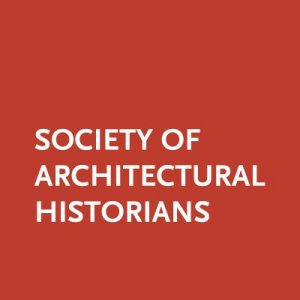H. Allen Brooks Travelling Fellowship

The Society of Architectural Historians’ prestigious H. Allen Brooks Travelling Fellowship will be offered for 2026 and will allow a recent graduate or emerging scholar to study by travel for a continuous period of three, six or twelve months. In response to the uncertainty of travel and to broaden the accessibility to applicants who may not be able to take a full year of travel, for whatever reason, the Society is amending the proposal requirements to include partial-year itineraries.
The fellowship is not for the purpose of doing research for an advanced academic degree or publication. Instead, Professor Brooks intended the recipient to study by travel and contemplation while observing, reading, writing, photographing, or sketching.
The goal of the fellowship is to provide an opportunity for a recent graduate with an advanced degree or an emerging scholar to:
- see and experience architecture and landscapes firsthand
- think about their profession deeply
- acquire knowledge useful for the recipient’s future work, contribution to their profession, and contribution to society
The fellowship recipient may travel to any country or countries during the three-months-to-one-year period. This fellowship is funded by the Society of Architectural Historians’ H. Allen Brooks Travelling Fellowship Fund.
The Award
The H. Allen Brooks Travelling Fellowship will cover expenses incurred by the Brooks Fellow for three months to one year of continuous travel. The 2026 award(s) could range from $18,750 (three-month award), $37,500 (six-month award) to $75,000 (one-year award). The award is non-renewable; award amounts may vary from year to year. The award will be paid in quarterly installments. SAH suggests that if additional financial support is needed to cover other related expenses, that the applicants contact their respective university/college, academic adviser, department head, employer or outside foundations to investigate the financial opportunities afforded them.
Award Schedule
- July 1, 2025: Application period opens
- August 31, 2025 at 11:00 pm CDT: Application period closes
- September–November 2025: Jury deliberations
- January 2026: Award(s) announcement
- January 1, 2026: Travel may begin as early as this date
Criteria
- Active membership in SAH. Become a member
- PhD or an advanced terminal degree in a field related to the built environment. Eligible degree dates are between January 1, 2020, and June 30, 2025.
Priority will be given to those whose chosen profession is relevant to the interests and objectives of the Society of Architectural Historians, i.e., the history of the built environment, historic preservation, conservation, and social implications of architecture, landscape architecture, and urbanism.
PLEASE NOTE: As stated above, this Fellowship is not intended to support research in pursuit of an advanced degree or publication. The intent is to provide support for personal enrichment and growth through travel.
The fellowship is intended to be a special honor for the recipient and is to be awarded to a truly outstanding candidate, based on distinguished academic achievement, leadership potential, personal motivation, and promise. The Brooks Fellow will be selected by the H. Allen Brooks Travelling Fellowship Committee, which is appointed by the president of SAH.
A terminal degree is the highest degree awarded in a given field. Such degrees include PhDs in the history, theory or criticism of architecture, landscape architecture, interior architecture, or urbanism; historic preservation; and the practice of architecture, landscape architecture, and urban planning. Advanced terminal degrees related to the built environment include, but are not limited to, an MArch, MUP, MLA or a master's in a historic preservation program.
This is an international fellowship; candidates from any country may apply. Current students are not eligible.
Reporting Requirements
The Brooks Fellowship recipient will be expected to keep an online journal by posting at least once per month to the SAH Blog. The blog posts will document the fellow’s travels in text, photographs, video, drawings, and other media. This record will be used by the SAH office to approve payment distribution.
At the conclusion of their travel, fellowship recipients will write a summary article for the SAH Newsletter (500–1,000 words) that documents their travel, explains how the fellowship contributed to the recipient’s understanding of the built environment, and details how they anticipate the fellowship will influence their future work.
While traveling or shortly thereafter, the fellowship recipient also will be expected to upload images to SAHARA, the SAH digital image archive. The recommended number of images to upload is 500 for a one-year fellowship, 250 for a 6-month and 125 for a 3-month. Upon their return, fellowship recipients will make themselves available to their local SAH chapter, should the chapter wish to hear a presentation about the fellowship year.
Application Details
Applicants must be active members of SAH. Become a member.
To apply, upload the following items to Dropbox in seven separate files:
- A statement (in English, 1000 words max) that details:
- Your academic and career goals
- What you hope to achieve intellectually during the fellowship period
- How this fellowship will advance your academic interests and will make a difference in your professional work.
- A proposed travel itinerary outlining travel sites and buildings or landscapes at those sites. Submitting a Google map outlining the sites is recommended.
- A proposed budget for a continuous travel period of three, six, or twelve months. Please use our budget template (click to download Excel spreadsheet).
- A two-page writing sample
- Proof of terminal degree and date (photocopy of diploma), see above criteria
- Curriculum vitae (2 pages maximum)
- Five representative photographs taken by the applicant (low resolution)
Name each files as follows:
- Your last name_statement
- Your last name_itinerary
- Your last name_budget
- Your last name_writing_sample
- Your last name_degree
- Your last name_CV
- Your last name_photos
Submitted separately:
- Two recommendations (must be submitted using the online recommendation form)
Recommendations should be submitted by thesis advisers or individuals who can critically assess the applicant’s academic and/or professional work. Recommenders will be asked to assess the applicant’s intellectual curiosity, scholarly ability, and potential to benefit from the fellowship. They will also be asked to provide evidence of the applicant’s distinguished academic achievement, leadership potential, and personal motivation. Send a link to this webpage to your recommenders and ask that they complete step 3 at the top of this page.
